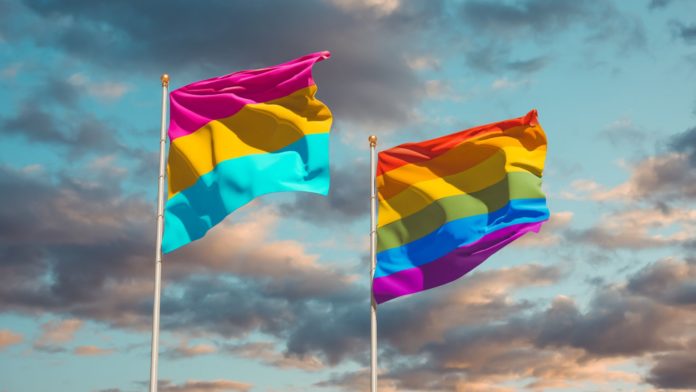The topic of one’s sexuality has certainly evolved in recent years. And it’s become a much more popular, and openly discussed topic. Once upon a time people rarely shared their sexual preferences so honestly, and whether you were interested in men or women or both, it was not talked about publicly. But it’s 2019 and people are proudly shouting their sexuality from the rooftops. No longer it is as black and white as straight or gay — there are shades of gray and the term “pansexual” has become an increasingly common way that people describe their sexual orientation. But what exactly does it mean?
Pansexual Implies a Sexual Attraction to All
According to the Merriam-Webster Dictionary, the definition of pansexual is: “of, relating to, or characterized by sexual desire or attraction that is not limited to people of a particular gender identity or sexual orientation.” Oxford Dictionaries continues to define this term as “Not limited in sexual choice with regard to biological sex, gender, or gender identity.” According to GLAAD, pansexual is defined as “a person who has the capacity to form enduring physical, romantic and/or emotional attractions to those of any or all genders,” reports CNN.
The prefix “pan” means “all,” and when combined with sexuality, the terms literally mean sexuality with all. It refers to people who are attracted to, and have sexual desire and sexual relationships with all genders and gender identities.
For many pansexuals, gender doesn’t even cross their minds as they develop a connection with or an attraction for another person. They can be attracted to multiple gender identities, because the romantic or sexual feelings are actually based on other qualities, and gender is irrelevant.
Pansexuality Has Existed Since the 20th Century
It seems like pansexuality is a new concept that has recently become more widely accepted thanks to celebrities and social media (we’re looking at you Miley Cyrus and Janelle Monáe); but is it really new, or just new to us? As it turns out, pansexuality actually existed back in the days of Sigmund Freud. While the term pansexual has gained recent popularity, especially among Millenials, the concept dates back to the early 1900s when the famous psychoanalyst suggested that “all human behavior is motivated in one way or another by the sex instinct,” regardless of who that sexual attraction is to. He believed the sexuality was the ultimate motivator behind all of our actions, and that motivation was not limited to one gender. His theory was widely criticized back in the day, but it also changed the way we think about sexuality and sexual drives, even today, a century later.
Back then Freud used the term pansexuality to refer to an overarching, all-consuming and all-inclusive sexual drive. It didn’t specifically refer to sexual orientation, as it does today, but to the sexual drive we all experience. It wasn’t until the 1940s that sexologist Alfred Kinsey introduced The Kinsey Scale, a scale that showed people did not necessarily fit into exclusive heterosexual or homosexual categories, but rather that their sexuality existed on a scale.
Today, the term pansexual is used a bit differently, but is strongly influenced by that early research that believed sexuality exists on a continuum, not being defined by finite boundaries. In today’s world, pansexual refers to a romantic relationship or a sexual attraction, regardless of one’s sexual orientation or gender. It’s not strictly about a sexual drive, but can be based on qualities other than sex or gender. In fact, for many pansexuals, gender doesn’t even cross their minds as they develop a connection with or an attraction for another person. They can be attracted to multiple gender identities, because the romantic or sexual feelings are actually based on other qualities, and gender is irrelevant.
That’s not to say that if someone is pansexual they aren’t drawn to another person because of their looks, it just means that the physical qualities you are attracted to have nothing to do with the person’s gender, and you could be drawn to someone of any gender identity.
Pansexuality Versus Bisexuality: Are They The Same Thing?
Still confused? Okay, let’s talk about how pansexuality and bisexuality are similar and different. Because they are not the same thing, but they do have some overlapping qualities.
First, let’s discuss the overarching term “queer.” Queer is often used as an umbrella term that refers to anyone who is, in any way, attracted to other people of the same gender and of all other genders. In other words, if you’re not exclusively heterosexual, you are queer. But bisexual is more specific in that it refers to someone who is interested in both men and women. If you’re bisexual you are sexually drawn to people of both genders — you are not exclusively hetero- or homosexual. You are both. You are attracted to more than one gender. Pansexual is not the same thing. If you are pansexual you are attracted to people of all genders, not just male and female, and your attraction occurs regardless of gender identity.
According to Ritch C. Savin-Williams, Ph.D., author and Professor Emeritus of Developmental Psychology at Cornell University, in an article for Psychology Today, pansexuality is “not about the sexual equipment of the individual or how feminine or masculine the individual is or feels (gender identity), but about the person as an individual — inclusive of just about anything.”
He goes on to quote studies published in the Journal of Sex Research by James S. Morandini and the International Journal of Social Inquiry, by Emily Lenning.
Morandini and colleagues pointed out, pansexuality per se “explicitly rejects attractions based on binary notions of sex (male versus female) and gender (man versus woman).” Lenning noted, “Whereas bisexuality implies a dichotomy, pansexuality suggests the possibility of attraction to a spectrum of gender identities,” explains Savin-Williams.
Celebrities Who Have Made Pansexuality Mainstream
While the popularity and awareness of pansexuality has been growing over time, and has certainly come a long way since the days of Freud, it recently came into its own thanks to celebrities like Miley Cyrus. In June 2015 Cyrus spoke openly about her sexuality in an interview with Paper Magazine. She described her sexuality as fluid.
.@JanelleMonae gave us a 🔥 💜 performance at the 61st #GRAMMYs. Watch the full performance of "Make Me Feel" https://t.co/x6mbJTPTzZ pic.twitter.com/yYzvYHZwVn
— Recording Academy / GRAMMYs (@RecordingAcad) February 15, 2019
“I am literally open to every single thing that is consenting and doesn’t involve an animal and everyone is of age. Everything that’s legal, I’m down with. Yo, I’m down with any adult — anyone over the age of 18 who is down to love me. I don’t relate to being boy or girl, and I don’t have to have my partner relate to boy or girl.”
While Cyrus helped bring the notion of pansexuality to the mainstream, she’s not alone. Actress Janelle Monáe, Jazz Jennings, actress Asia Kate Dillon and more also openly identify as pansexual. In fact, shortly after Monáe’s interview where she referred to herself as a “queer black woman in America” went viral, Internet searches for the term “pansexual” increased by 11,000% according to Pride.com.
Pansexuality and Polyamory Are Not The Same Thing
Another source of confusion, largely due to lack of awareness and education, is that people assume pansexuality (being attracted to anyone of all genders) is the same thing as being polyamorous (being in a relationship with multiple people at a time). They are very clearly distinct terms that refer to different aspects of a person’s sexuality.
Poly refers to the type of relationships you have, and means that you are not monogamous, but are in relationships with multiple people at once. It means you have the capacity to love more than one person at a time, and choose to be romantically or sexually involved with multiple people. Pansexual means that you can and are attracted to people of all gender identities, but in no way implies how many relationships you pursue at a given time.
And while we’re on the topic, genderfluid also does not mean the same thing as pansexual. Genderfluid refers to how you identify, whether you are male, female or you identify as a mix of genders or different genders on different days. It has nothing to do with your sexuality or whom you are attracted to, but how you identify personally.
Pansexuality and The Future of Sexuality
While we have come a long way in recent years, and many people are more familiar with LGBTQ lifestyles, there is still a lot we don’t talk about or know about sexuality. The education system only teaches so much, and most people have a limited understanding of certain sexuality labels, but hopefully that is beginning to change as pansexuality is more widely recognized and discussed in mainstream media.
Pansexuality is becoming more popular and more widely accepted, especially among a younger generation, which is a really good thing if you ask sociologists, clinical psychologists and sexuality experts. Because this term is incredibly broad and open — the heart of pansexuality is the ability to love and be attracted to anyone of any gender identity — it’s extremely appealing to younger people who are growing up in a world that is far more open to fluid gender roles and far less interested in labels.

According to Savin-Williams, pansexuality is not only real, but also really important for millennial youth. “Pansexuality offers teenagers an opportunity not to rule out anyone solely because of their sex or gender. It explodes traditional categorical identities, such as straight, bisexual, and gay,” he explains. It allows a freedom to explore all of your romantic and sexual attractions; all of your desires, and to truly consider what feels natural and right for you as an individual. It’s a broad term that allows people a sense of flexibility that was not as widely accepted in the past. And it gives people a choice — a choice of whom they want to be involved with, without feeling they necessarily need to label it or lock themselves in a sexuality box.
The term pansexual is inclusive and is not limiting. In the past a lack of knowledge led to significant misconceptions about what it means to be a pansexual, but as we embark on this new frontier of human sexuality, it looks like awareness and acceptance are growing, and you should expect to hear a lot more about pansexuality in the future.
For Image credit or remove please email for immediate removal - info@belatina.com






































